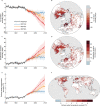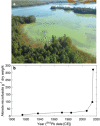Lakes in Hot Water: The Impacts of a Changing Climate on Aquatic Ecosystems
- PMID: 36325103
- PMCID: PMC9618276
- DOI: 10.1093/biosci/biac052
Lakes in Hot Water: The Impacts of a Changing Climate on Aquatic Ecosystems
Abstract
Our planet is being subjected to unprecedented climate change, with far-reaching social and ecological repercussions. Below the waterline, aquatic ecosystems are being affected by multiple climate-related and anthropogenic stressors, the combined effects of which are poorly understood and rarely appreciated at the global stage. A striking consequence of climate change on aquatic ecosystems is that many are experiencing shorter periods of ice cover, as well as earlier and longer summer stratified seasons, which often result in a cascade of ecological and environmental consequences, such as warmer summer water temperatures, alterations in lake mixing and water levels, declines in dissolved oxygen, increased likelihood of cyanobacterial algal blooms, and the loss of habitat for native cold-water fisheries. The repercussions of a changing climate include impacts on freshwater supplies, water quality, biodiversity, and the ecosystem benefits that they provide to society.
Keywords: climate change; ecology; environmental science; limnology; water resources.
© The Author(s) 2022. Published by Oxford University Press on behalf of the American Institute of Biological Sciences.
Figures




References
-
- Austin JA, Colman SM.. 2007.. Lake Superior summer water temperatures are increasing more rapidly than regional air temperatures: A positive ice-albedo feedback. Geophysical Research Letters 34: L06604.
-
- Bartosiewicz M, 2019.Hot tops, cold bottoms: Synergistic climate warming and shielding effects increase carbon burial in lakes. Limnology and Oceanography Letters 4: 132–144.
-
- Birk S, 2020. Impacts of multiple stressors on freshwater biota across spatial scales and ecosystems. Nature Ecology and Evolution 4: 1060–1068. - PubMed

